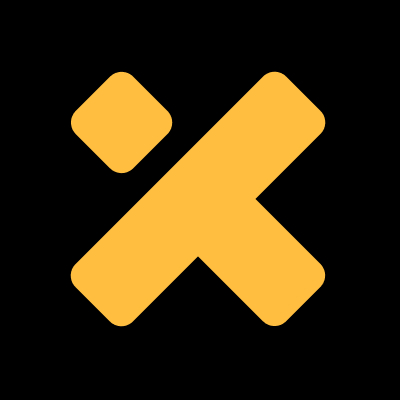Key Takeaways
– High-performance L1 blockchain, challenging Ethereum – Monad aims to solve Ethereum’s scalability problem, providing 10,000 TPS, 1-second block confirmation and ultra-low transaction fees, becoming a faster and cheaper option.
– Perfect compatibility with EVM, easy migration for developers – Monad is compatible with Ethereum Virtual Machine (EVM). dApps on Ethereum can be directly deployed to Monad without changing the code, which lowers the development threshold.
– Innovative technical architecture, improved performance – Through the MonadBFT consensus mechanism, parallel transaction processing, and exclusive MonadDB database, Monad makes transactions faster, costs less, and the blockchain more stable.
– The token issuance time has not yet been determined – The original plan was to launch the MONAD token in Q4 2024, but the official has not yet announced the specific time, and information about staking, governance, token distribution, etc. is still unclear.
– Well-funded but fiercely competitive – Received $225 million in Series A funding, but faces competitors such as Solana, Avalanche, and Ethereum Layer 2. Future success or failure depends on developer adoption, ecosystem development, and mainnet launch progress.
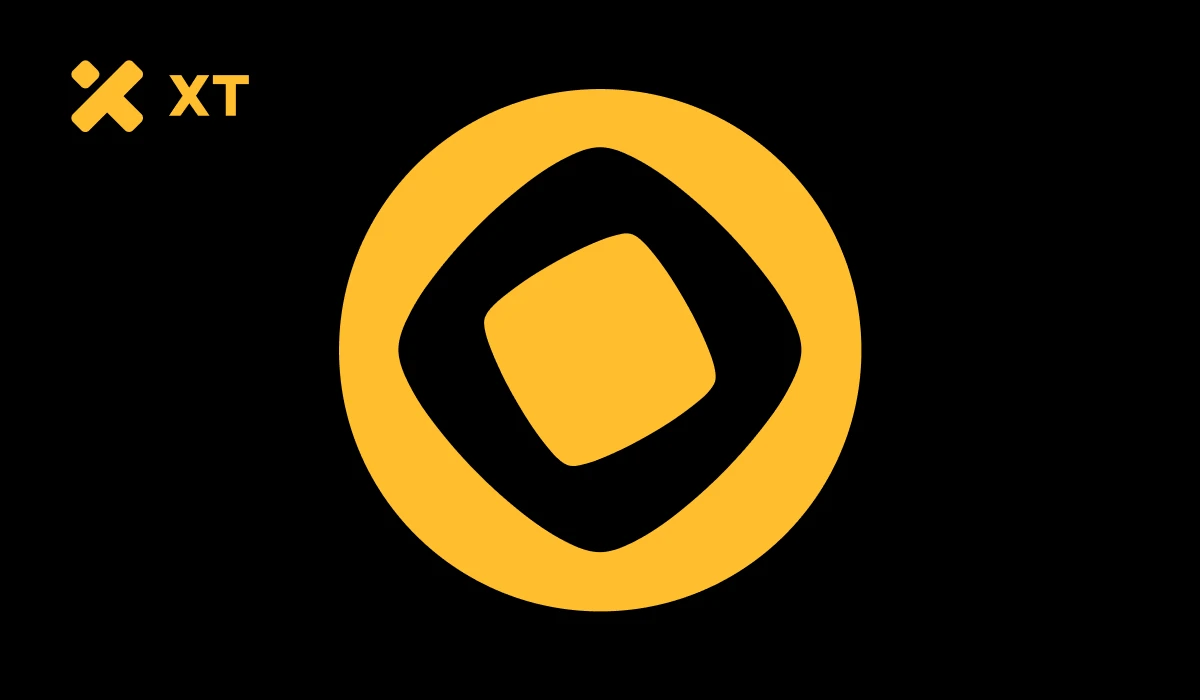
Blockchain technology has evolved from a niche concept to a core tool in finance, gaming, and e-commerce. However, mainstream blockchains such as Ethereum still face problems such as high fees, slow transaction speeds, and limited throughput. These bottlenecks not only affect the user experience, but also constrain developers, thus hindering the large-scale adoption of decentralized applications (dApps).
Monad provides a brand new solution. This Layer 1 blockchain is not only compatible with Ethereum EVM, but also provides ultra-fast transaction speeds and ultra-low fees. It combines parallel execution, innovative consensus mechanisms, and custom data storage systems to create an efficient and user-friendly blockchain network to support large-scale practical applications.
This article will give you an in-depth understanding of Monads origins, technical architecture, and development roadmap. If you are a developer looking for a more efficient blockchain, or interested in the future trends of the Web3 ecosystem, this article will help you understand the importance of Monad and how it may reshape the market landscape.
Table of contents
Development History and Current Situation
Monads Positioning in the Blockchain Ecosystem
MONAD Token Potential and Applications
Challenges and Future Prospects
Who is the creator of Monad?
The story of Monad can be traced back to February 2022, when three experts in the fields of blockchain and fintech co-founded the project to solve the current blockchain scalability problems:
– Keone Hon (CEO) – A senior blockchain researcher and mathematician, focusing on developing innovative technologies that can solve blockchain performance bottlenecks.
– James Hunsaker (Chief Technology Officer, CTO) – An expert in cryptographic protocols and distributed systems, he is responsible for Monad’s technical strategy and ensuring that blockchain achieves optimal performance in terms of speed and scalability.
– Eunice Giarta (Chief Operating Officer, COO) – Responsible for Monad’s operational structure, managing resource allocation, partnerships, and strategic planning to drive the project’s stable development.
The three founders have extensive backgrounds in blockchain technology and experience in the financial field. Their common vision is to build a high-speed, stable, and low-cost blockchain platform while maintaining Ethereum Virtual Machine (EVM) compatibility, allowing developers to seamlessly migrate existing applications and easily deploy new dApps.

Image Credit: Bankless
What is a Monad?
Essentially, Monad is a Layer 1 (L1) public chain that focuses on solving the two major problems of low blockchain scalability and high transaction fees. Through technological innovation, Monad hopes to stand out in the fiercely competitive market and provide:
– High Throughput: The goal is to reach 10,000 transactions per second (TPS), which is much higher than Ethereum’s current ~15 TPS.
– Low Latency: 1 second block time and support for Single-Slot Finality, ensuring transactions are confirmed almost instantly.
– Minimal Fees: Reduce transaction costs to make applications such as DeFi, NFT, and GameFi more popular and more affordable.
– Full EVM Compatibility: Developers can migrate dApps to Monad without major modifications to existing Ethereum smart contracts, lowering the technical threshold.
By focusing on speed and accessibility, Monad hopes to become a versatile blockchain platform that can run and develop smoothly, whether it is decentralized finance (DeFi), NFT ecology, or enterprise-level applications.
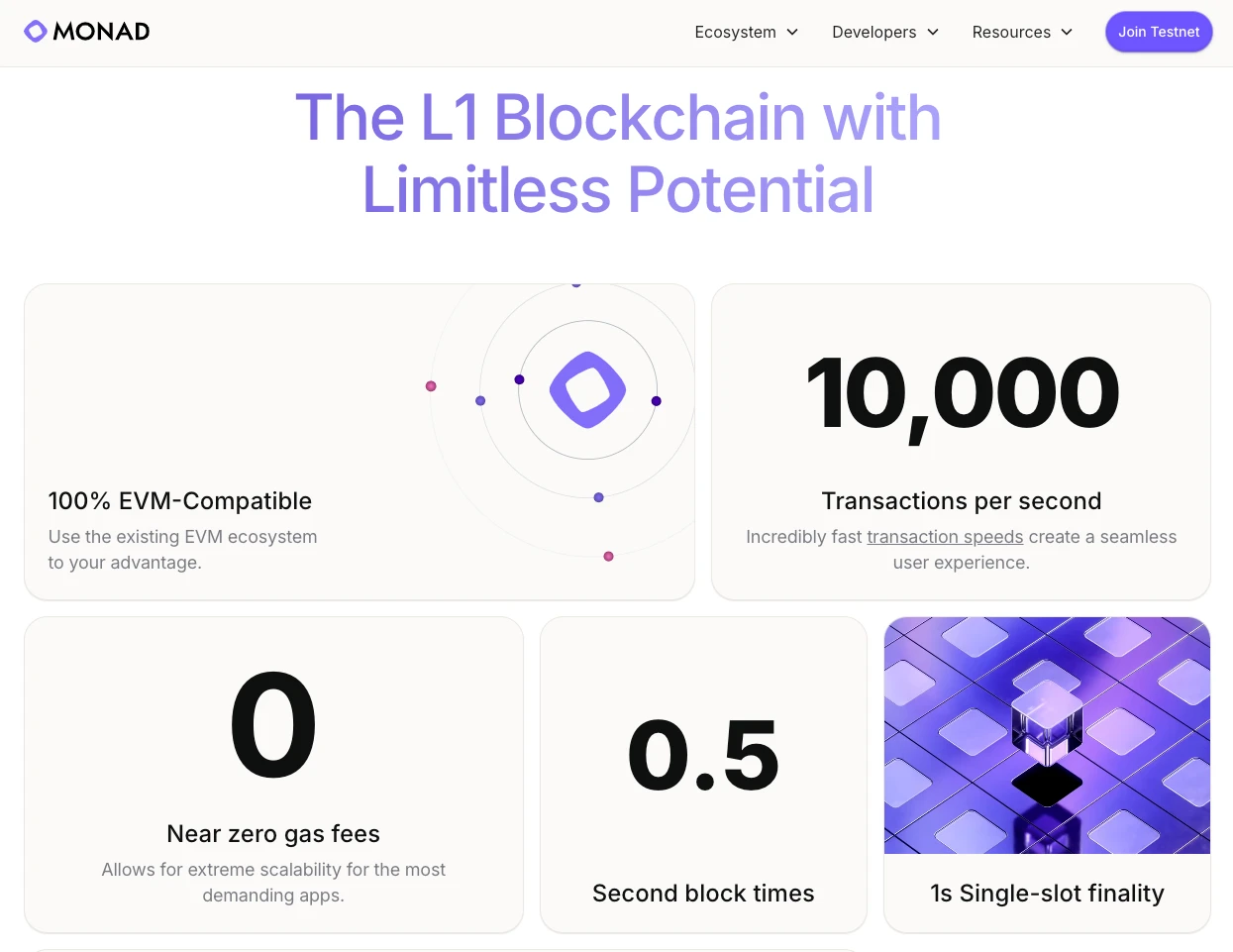
Image Credit: Monad
Development History and Current Situation
Monads development history can be traced back to 2022, from early concepts to test network launch, step by step towards a complete blockchain ecosystem.
– February 2022: The Monad founding team began to conceive and design the basic concepts of the blockchain protocol.
– February 2023: Successfully obtained US$19 million in seed round financing, which helped promote early technology research and development, including the development of consensus mechanisms and testing of prototype systems.
– April 2024: Completed a US$225 million Series A financing round, demonstrating investors’ high confidence in the project and further accelerating technology development and community expansion.
– December 2024: Monad Foundation is established to be responsible for protocol governance, developer grant program, ecosystem construction and technology upgrades. Many open source blockchain projects rely on foundations to promote long-term development and ensure the stable growth of the blockchain community.
– February 2025: Monad officially launches the Public Testnet , providing developers with a testing environment that supports EVM-compatible tools, allowing dApps to be deployed and tested in advance. This is an important step before the mainnet launch to ensure system stability and optimization of the development experience.
Although the mainnet was originally planned to be launched in Q4 2024, the official launch time has not yet been officially confirmed. In addition, detailed information about the native token MONAD has not yet been made public. In addition to the previously mentioned issuance plan, the official has not yet announced the token economic model (Tokenomics), staking mechanism (Staking) or token distribution details.
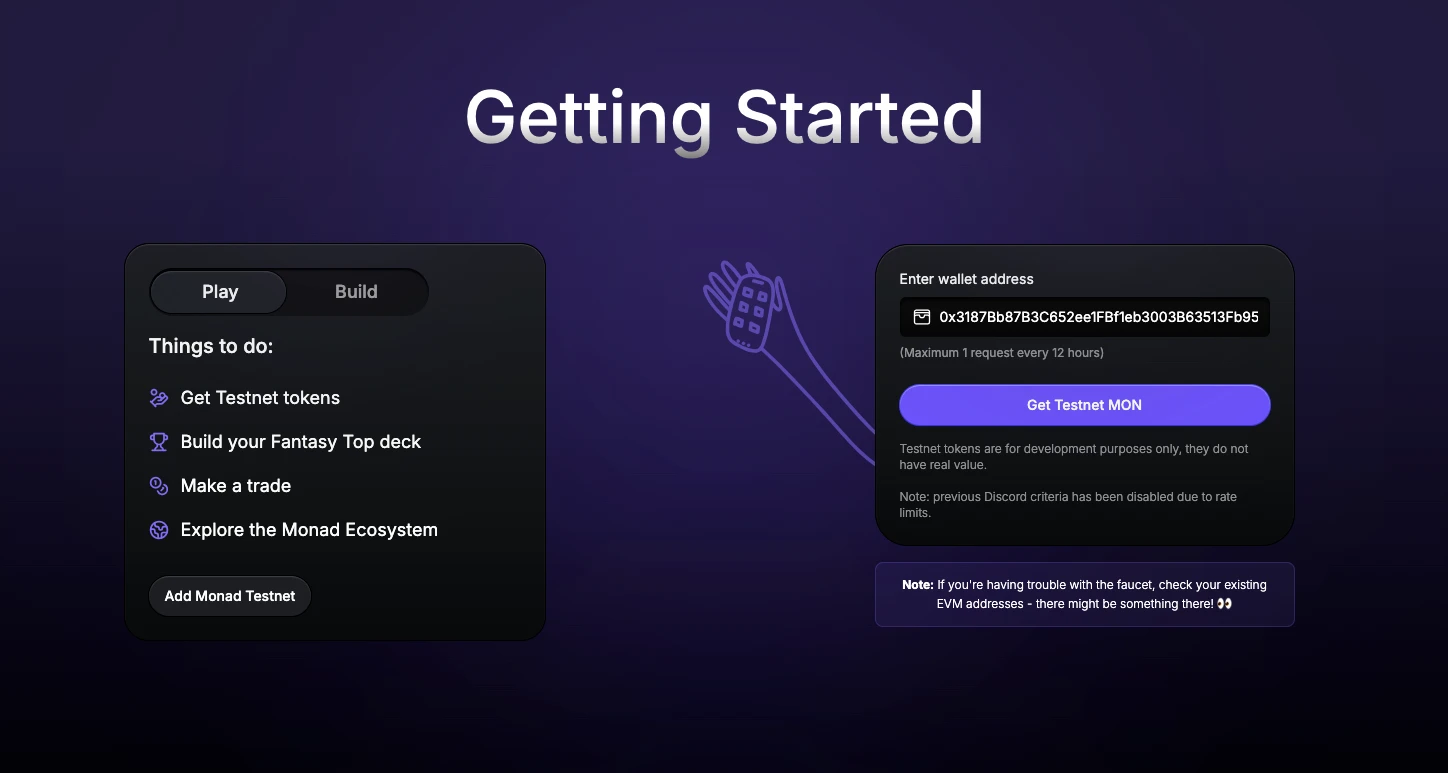
Image Credit: Monad Testnet
Monads Positioning in the Blockchain Ecosystem
The current blockchain market is highly competitive, and various solutions are trying to overcome the limitations of Ethereum . Whether it is Layer 2 expansion solutions (such as Arbitrum , Optimism ) or other high-performance Layer 1 public chains (such as Solana , Avalanche ), they are all vying for the favor of developers and users.
Monads unique positioning combines two core advantages:
– Native Scalability: Unlike Layer 2, which relies on Ethereum’s security and cross-chain bridge mechanism, Monad, as an independent Layer 1 public chain, is designed with high throughput (10,000 TPS) and does not require an additional expansion layer to improve performance.
– Seamless EVM Compatibility: Fully compatible with Ethereum, which means that developers can migrate existing smart contracts and decentralized applications (dApps) to Monad with almost no code modification, reducing migration costs and technical barriers.
With these features, Monads ecosystem is particularly suitable for applications that require high performance and low fees, such as:
– Decentralized Finance (DeFi) – High-frequency trading, liquidity mining, and automated market makers (AMMs) require low latency and high throughput, and Monad’s architecture meets these requirements.
– Blockchain Games (GameFi) – Due to the frequent transactions and item transfers within the game, developers prefer to use blockchains with low transaction fees and instant settlement, and Monad provides a more attractive environment for this.
– NFT Ecosystem – Whether it is NFT minting or market trading, Monad’s low-cost, high-performance design ensures that the user experience is not affected by gas fees and improves market liquidity.
With such a market positioning, Monad hopes to become one of the preferred platforms for developers and enterprises to build blockchain applications, challenging the current mainstream L1 and L2 solutions.
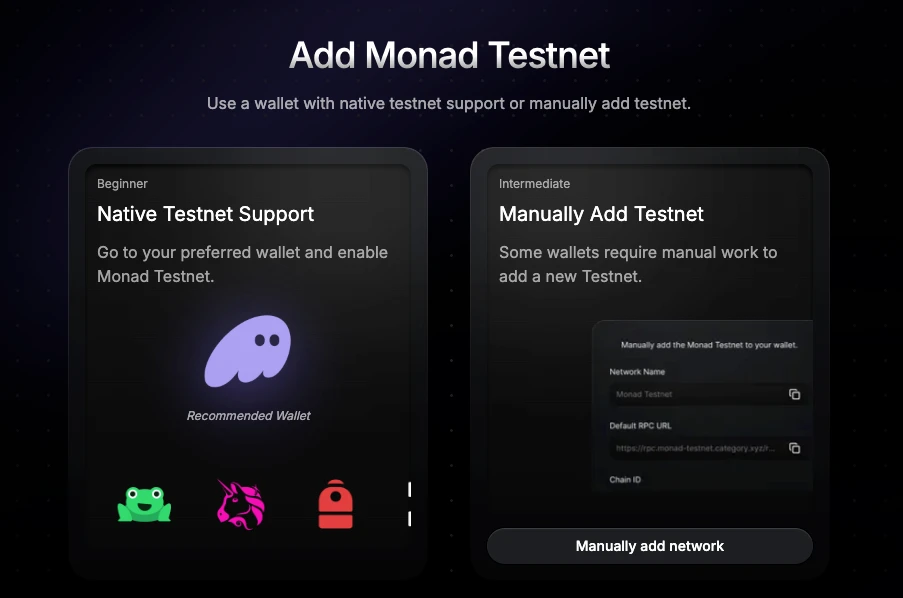
Image Credit: Monad
Why are Monads important?
Solving scalability issues
Ethereum s network congestion often causes slower transactions and higher gas fees, especially during NFT minting or popular DeFi events. This bottleneck makes small transactions uneconomical and limits the large-scale adoption of Web3 applications.
Monad hopes to solve this problem through its 10,000 TPS high-throughput architecture, providing a smooth and scalable infrastructure for DeFi platforms, game ecosystems (GameFi), and even enterprise applications (Enterprise Solutions), and promoting large-scale adoption of Web3.
Improve user experience
Monad uses a 1-second block time and supports Single-Slot Finality, which means that transactions can be confirmed instantly without waiting for multiple blocks to be confirmed like Ethereum.
This low latency feature is crucial for everyday users, especially in application scenarios that require fast response, such as decentralized exchanges (DEX), in-game transactions (In-Game Transactions), and NFT trading markets, which can bring a smoother experience.
Lowering the barriers and costs of participation
Ethereums high gas fee has become a major obstacle to the popularization of Web3, and many small investors or gamers are deterred by high transaction costs. For example, buying an NFT worth $5 on Ethereum may require a fee of more than $20, which makes many users choose to give up the transaction.
Monads low-fee design makes small and frequent transactions feasible. Whether DeFi users, game players, or ordinary users, they can participate in Web3 applications on Monad at a lower cost and expand the overall user base.
Keep the tools and environment familiar to developers
Developers usually want to use the development frameworks and tools they are familiar with, and Monad is fully compatible with Ethereums EVM (Ethereum Virtual Machine), which means:
– Existing smart contracts can be migrated to Monad with little to no modification.
– dApp developers can continue to use familiar development tools such as Solidity, Hardhat, Remix, etc. without having to learn a completely new language or architecture.
– Reduce technology migration costs, making Monad a more attractive alternative to Ethereum.
This EVM compatibility makes it easier for Monad to attract developers, accelerate the growth of the ecosystem, and further promote the adoption of Web3.
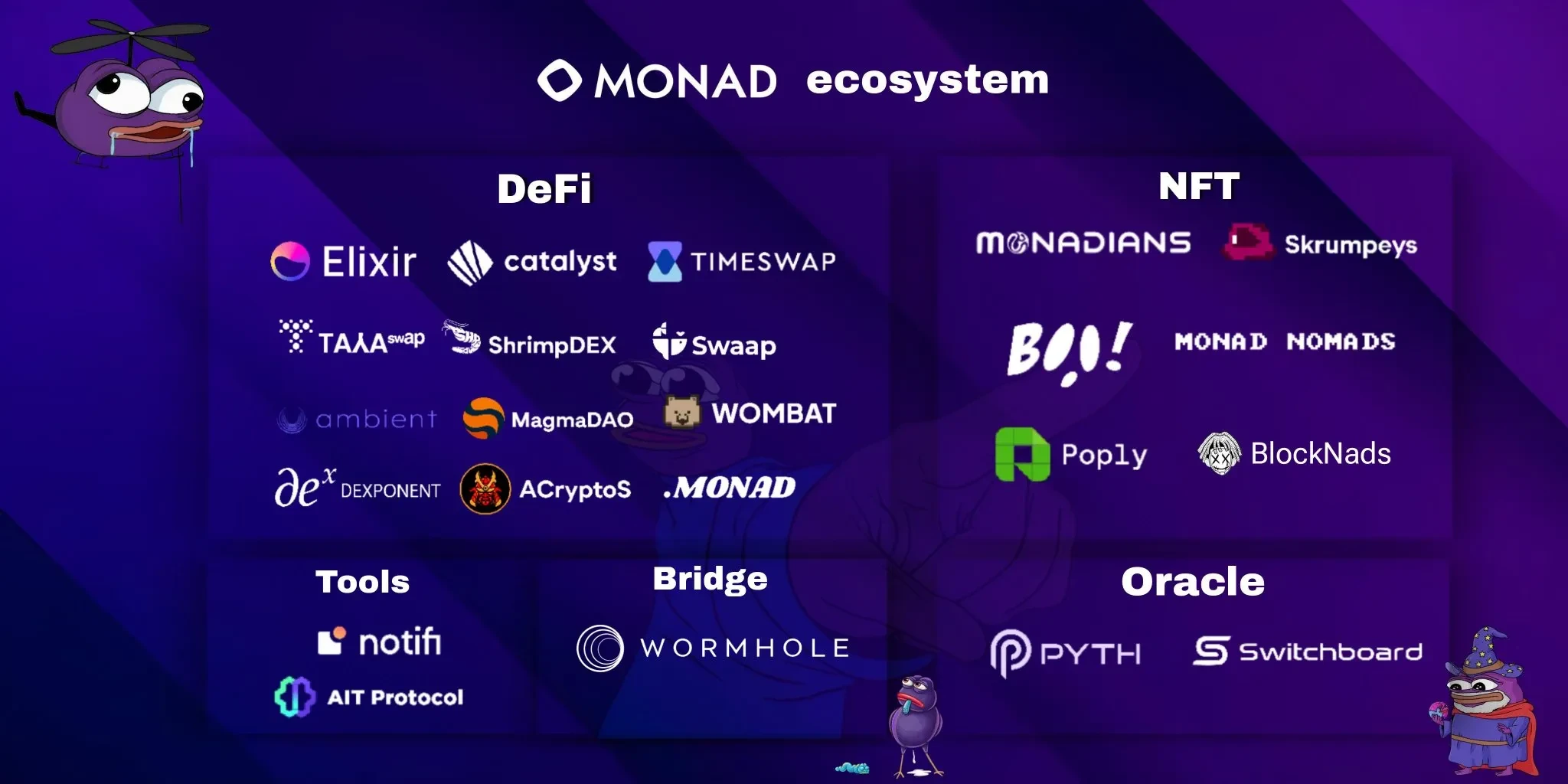
Image Credit: The Coinomist
How do Monads work?
Monad is able to achieve high performance mainly due to three core technology innovations, which complement each other and jointly improve the speed, throughput and scalability of the blockchain:
MonadBFT Consensus Mechanism
Monad uses the Byzantine Fault Tolerant (BFT) consensus mechanism. Even if a small number of nodes (less than 1/3) act maliciously or fail, the entire system can still run safely and quickly confirm transactions.
The advantage of BFT consensus is low latency, which allows blocks to be generated quickly and ensures transaction finality. Through MonadBFT, Monad can achieve 1 second block time, allowing transactions to be confirmed almost instantly, greatly improving user experience.
Parallel Execution
Traditional blockchain transactions are usually processed sequentially, which means that all transactions must be confirmed in order. This mode of operation will become a performance bottleneck when the blockchain traffic increases.
Monad uses parallel execution to separate transaction sorting from execution, allowing non-conflicting transactions to proceed simultaneously. This technology greatly improves throughput, allowing multiple transactions to be processed at the same time, thereby achieving the goal of 10,000 TPS.
MonadDB (Blockchain-specific database)
Data storage is an easily overlooked aspect of many blockchain infrastructures. Traditional data storage methods may cause nodes to be overloaded and affect transaction processing efficiency.
Monad has developed a proprietary database technology - MonadDB, which is a key-value storage system optimized for blockchain verification and query. It has:
Fast Read/Write: Ensures instant access to transaction data, reducing latency.
Authenticated Storage: Ensuring the integrity of each piece of data through encryption verification and maintaining the security of the blockchain.
Optimized Hardware Efficiency: Reduce the nodes reliance on advanced hardware and ensure that Monad can run efficiently on standard devices.
Through these three core technologies, Monad can not only provide a high-throughput, low-latency blockchain environment, but also ensure the security and stability of the system, providing an ideal operating foundation for applications such as DeFi, NFT, and GameFi.
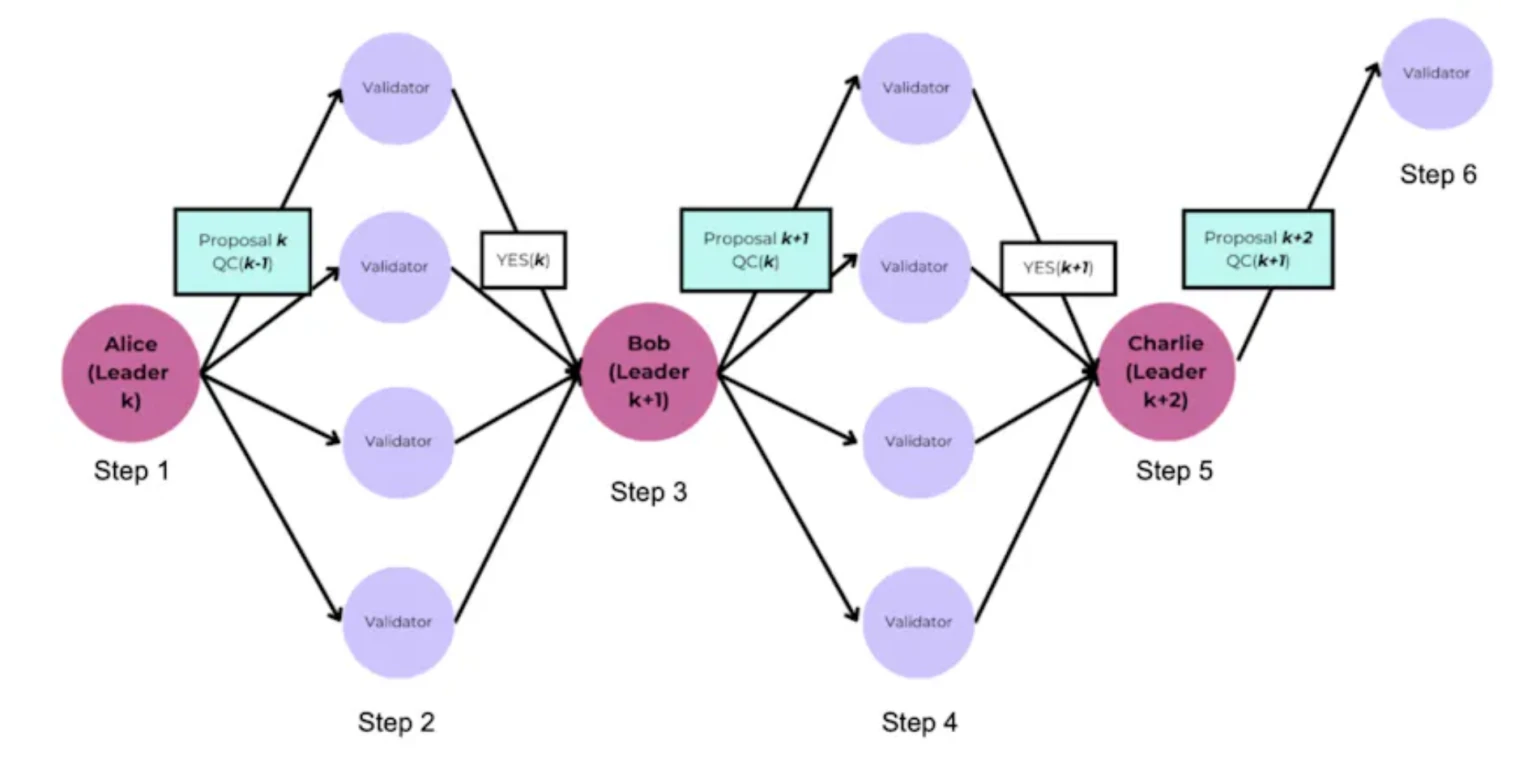
Image Credit: The Coinomist
MONAD Token Potential and Applications
Although the market is full of expectations for the MONAD token, the official has not yet announced the final token economic model (Tokenomics) or the exact release time.
The original plan was for MONAD tokens to be released with the launch of the mainnet, but the current timeline remains uncertain and no official information has been provided on the supply and distribution mechanism.
Potential Uses
If the MONAD token is officially launched, it is expected to cover the following key functions:
– Transaction Fees: MONAD may become the main token for paying transaction fees, incentivizing validators through Gas fees while preventing spam transactions.
– Staking Security: Holders may be able to stake MONAD in the MonadBFT consensus mechanism to support network operations and receive staking rewards.
– Community Governance: Similar to many blockchain projects, MONAD token holders may be able to participate in decentralized governance and vote on key decisions such as protocol upgrades, foundation funding allocations, community proposals, etc.
What we don’t know yet
Although the MONAD token has received widespread attention, there are still some unanswered questions, including:
Supply and Distribution:
– What will the total supply of MONAD tokens be?
– Will there be a public sale, or will the shares be mainly purchased by private investors?
Release Schedule:
– How is the vesting schedule for team members, early investors, and developer grant funds arranged?
– Will there be a pre-mine or community airdrop?
Investor confidence vs. market uncertainty
Monad raised $225 million in its Series A, which shows that investors are confident in the project’s potential. However, the market is still waiting to see the details of the token economics (Tokenomics) before the official token whitepaper is released.
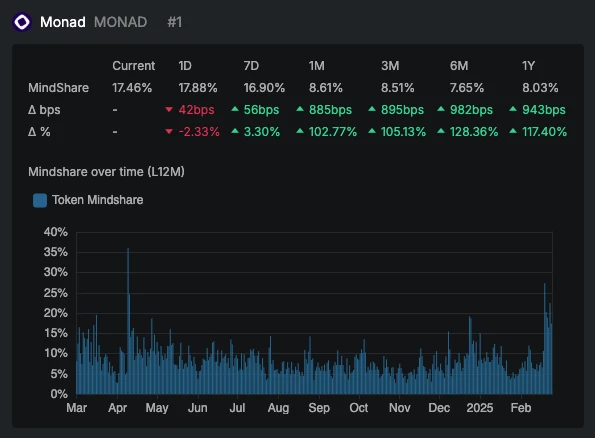
Image Credit: Kaito AI
Challenges and Future Prospects
Competitive pressure
Monad enters a highly competitive market. There are already many high-throughput public chains and Layer 2 solutions competing for developers and users, including:
– Solana – features high-speed transactions and low fees, and already has a huge DeFi and NFT ecosystem.
– Avalanche – provides high scalability through the subnet mechanism, attracting enterprise-level applications and gaming projects.
– Aptos Sui – uses the Move programming language, focuses on improving transaction efficiency, and competes in the new generation of high-performance blockchain market.
– Layer 2 solutions (such as Arbitrum and Optimism ) – rely on the security of Ethereum while significantly reducing transaction costs and increasing processing speed, and have become a popular choice for developers.
If Monad wants to break through, it must emphasize the combination of its parallel transaction execution (Parallel Execution) and EVM compatibility, so that developers can feel its technical uniqueness and advantages.
Developer adoption
The success of a blockchain depends on the quantity and quality of applications within its ecosystem. Currently, developers will not easily migrate from Ethereum or other L1/L2, and Monad needs to invest a lot of resources to attract developers, such as:
– DeFi protocols – such as DEX, lending protocols, derivatives markets, etc., which are the core of the blockchain ecosystem.
– NFT Platform – NFT markets, art transactions, digital identity verification, etc. require low-fee, high-throughput blockchain support.
– Blockchain Games (GameFi) – Blockchain games with high-frequency transactions require a fast and low-cost chain to enhance the gaming experience.
Monad needs to launch hackathons, developer grants, and improve development tools to stimulate ecological growth. Only by building an active dApp community can it truly compete with other blockchains.
Regulatory environment
Regulatory changes around the world may affect Monads development, especially in the following areas:
– Token Launch – Many countries have strict regulations on the issuance of new tokens. If MONAD tokens are considered securities, their circulation and trading may be affected.
– Staking – Certain jurisdictions have regulations on staking, which may affect the availability of MONAD in different regions.
– Decentralized Governance – If the governance mechanism of DAO (decentralized autonomous organization) is involved, it may be subject to regulatory review in the United States, the European Union and other regions.
If the regulatory environment becomes more stringent, Monad may need to adjust its token economic model or legal structure to ensure compliance.
Uncertain development roadmap
At present, Monad has not yet announced the official launch time of the mainnet, which is an uncertain factor for investors and developers.
If the project fails to provide transparent development progress and testnet updates, many developers may choose to wait and see, or even turn to other competing chains. In order to maintain market confidence, the Monad team needs to:
- Regularly update the progress of the Testnet
– Collect community feedback
– Public mainnet deployment plan
This is the only way to ensure long-term trust in its technology and ecosystem from investors and developers.
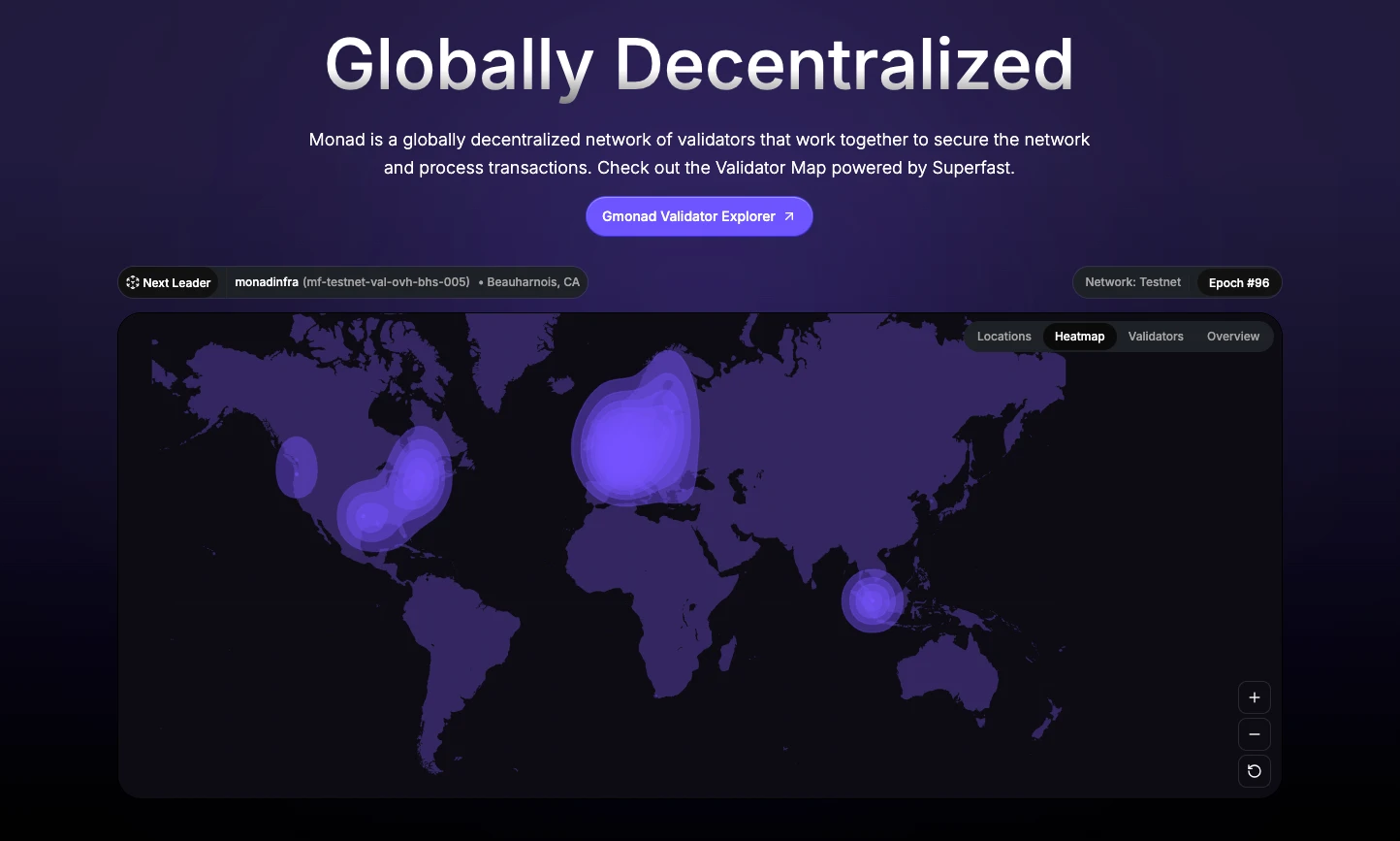
Image Credit: Monad
in conclusion
Monad is an ambitious initiative to solve the long-standing scalability problem of blockchains.
Through EVM compatibility and high-performance technologies (such as parallel transaction execution and MonadBFT consensus mechanism), Monad hopes to provide a fast and low-cost transaction environment to meet the needs of a variety of real-world applications.
However, despite its exciting technical potential, Monad still faces many challenges:
– The timing of mainnet launch and token issuance is still unclear, resulting in uncertainty in market and developer adoption.
– Tokenomics and governance mechanisms have not yet been fully disclosed, affecting investor confidence.
– Competitors are strong. Many mature Layer 1 (such as Solana, Avalanche) and Layer 2 (such as Arbitrum, Optimism) already have complete ecosystems and stable user bases.
Even so, Monad still has several strong advantages that make it a good candidate to become an important platform in the next generation of blockchain:
– Experienced founding team
– Received USD 225 million in Series A funding and has sufficient development resources
– Focus on EVM compatibility and high-performance throughput, providing a better choice for the Ethereum ecosystem . If Monad can successfully implement its technical promises and attract developers to participate in ecosystem construction, it may become a new generation of innovative platform in the blockchain field and occupy a place in the Web3 ecosystem.
Quick Links
– Hong Kong Web3 Revolution: Key Trends and Regulatory Policies Released by Consensus 2025
– Nine Cryptocurrency Trends in 2025: AI, DeFi, Tokenization, and More Innovations
– Pi Network Open Mainnet is coming soon - key information you need to know
About XT.COM
Founded in 2018, XT.COM currently has more than 7.8 million registered users, more than 1 million monthly active users, and more than 40 million user traffic within the ecosystem. We are a comprehensive trading platform that supports 800+ high-quality currencies and 1,000+ trading pairs. XT.COM cryptocurrency trading platform supports a variety of trading products such as spot trading , leveraged trading , and contract trading . XT.COM also has a safe and reliable NFT trading platform . We are committed to providing users with the safest, most efficient, and most professional digital asset investment services.

